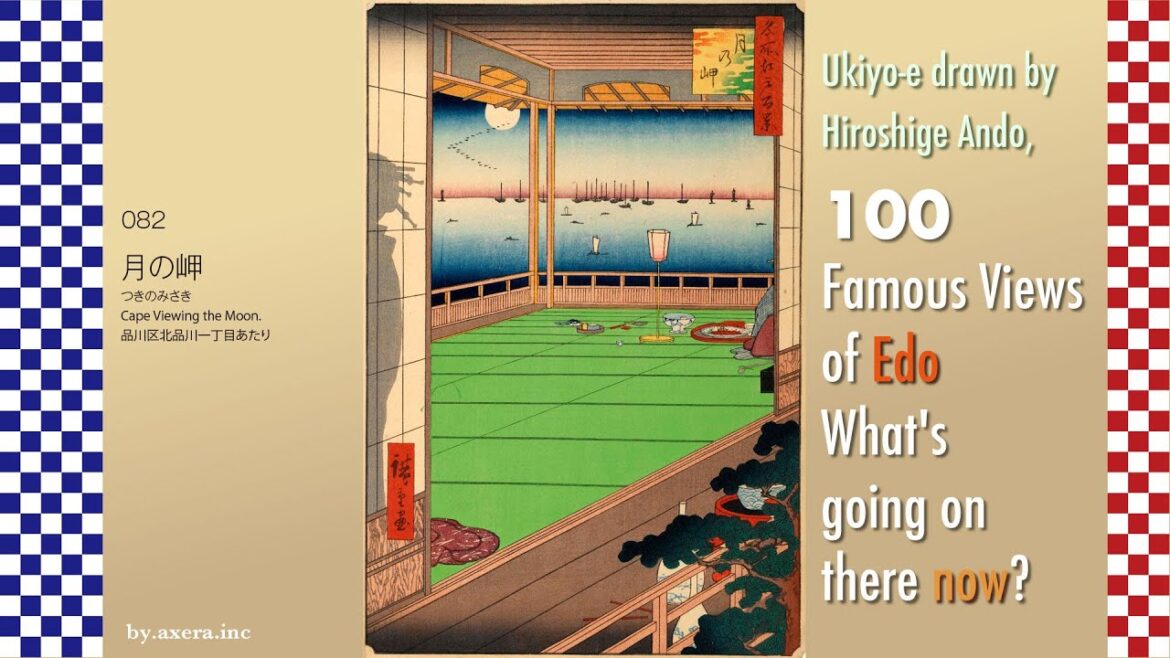https://www.axera.co.jp/edo100views/index.html
Ukiyo-e series drawn by Hiroshige Ando in the Edo period,
100 Famous Views of Edo, the place where it was set
I asked him what was actually happening now.
Click here for Japanese version.
https://www.axera.co.jp/edo100/index.html
Please see the homepage for all the explanations.
I visited my favorite 100 Famous Views of Edo painted by Hiroshige Ando to see what the scene looks like today.
It is said that “Cape Viewing the Moon” in 082 is a view of the sea from around what is now Kita-Shinagawa 1-chome. At the time of Hiroshige, there was nothing to the immediate east of this area but the ocean.
Now, please check the map to see where this “Dozo Sagami” is located and in which direction you are looking. This time, I have used a screen capture from Tokyo History Map. The reason is that you can clearly see the transition of the sea topography. First, please look at the GSI map, and then cover it with the map from the end of the Edo period.
As you can see from this map, the sandy beach brought by the Meguro River spread out in the North Shinagawa, and the vast sandy beach brought by the Tama River spread out in the South Shinagawa. The famous rakugo story “Shinagawa Shinju (double suicide)” was set on this vast sandy beach with a prostitute at Shinagawa-juku. The story was made funny because Kinzo, who could not swim, did not die when he was pushed off the pier by Osome, a prostitute, on this shallow sandy beach.
Now let’s actually take a closer look at Hiroshige’s painting.
First, outside the window is the sea with large ships anchored far out to sea. The moon is floating in the sky, and geese are flying next to it.
Inside the room, there is a Bonbori (paper lantern), a cup washer, a cup, a tray, a fan, and what looks like red fish sashimi. Next to the tray, the hem of a geisha and the pole of a shamisen (a three-stringed Japanese instrument) peek out. Was she playing with them until now?.
Such a thought-provoking pattern is rare in this series, and the only other paintings in this series that depict scenery in that direction are View 39, “Azumabashi Bridge Kinryuzan Distant View,” and View 101, “Asakusa Tanbo Torinomachi Pilgrimage,” but View 82 is the only one that depicts scenery that is not in that direction.
Since Hiroshige titled this painting “Cape Viewing the Moon,” it is thought to be a scene from just after the annual Nijurokuya-no-Yoru (Twenty-six Night Waiting) banquet held in July.
The twenty-sixth night of waiting is also depicted by Hiroshige in his picture book “Edo Souvenirs” with detailed explanations.
In the Edo period (1603-1867), people waited for the moon to rise on the 26th night of the first and seventh months of the lunar calendar and worshipped it, which was called “26-night waiting. It was said that the three deities Mida, Kannon, and Seishi would appear in the moonlight, and especially in July, the area from Takanawa to Shinagawa, which was said to be one of the best places to see the moon, was very crowded.
Hiroshige left various pictures of this scene.
Many people crowded along the road from Takanawa to Shinagawa, enjoying sake, food, songs and dances, rakugo (comic monologue), lanterns, and street lectures while they waited for the moon to rise.
I actually went to this location. There is now an apartment building with a convenience store where the Dozo Sagami used to be, so I moved a little to the north and looked for a view out toward the ocean, and took this shot.
From this location, swing the camera toward Kawasaki on the old Tokaido. About 30 meters from here, on the left, is Dozo Sagami.
The official name of the inn, Sagamiya, was a storehouse with a sea cucumber fence on the exterior, and was commonly called “Dozo Sagami”. Sagamiya was one of the largest brothels in Shinagawa, and was known as the place where Shinsaku Takasugi, Hirobumi Ito, and other patriots at the end of the Edo period held secret ceremonies. The building seems to have survived until the early Showa period.
I swung the camera in the opposite direction toward Shinagawa Station. This is now the Keikyu railroad crossing.
I tried to fit the present image into Hiroshige’s painting.
In fact, I took the picture from a slightly elevated position near where the storehouse Sagami used to be, and inserted only the window. Of course, you cannot see the sea at all, only buildings.
A few years after Hiroshige painted this picture, under the name of the Meiji Restoration, the country was being industrialized, the beautiful beaches were being reclaimed, and the sea, which had been a treasure house of fish, was being transformed into a smelly, sludgy sea. The sea, once a treasure trove of fish, has been transformed into a smelly sludge. The time when we are allowed to enjoy the elegance of waiting for the moon to rise while gazing at the beautiful sea will probably never come again.
I wish I could see the three deities appearing in the moonlight.

